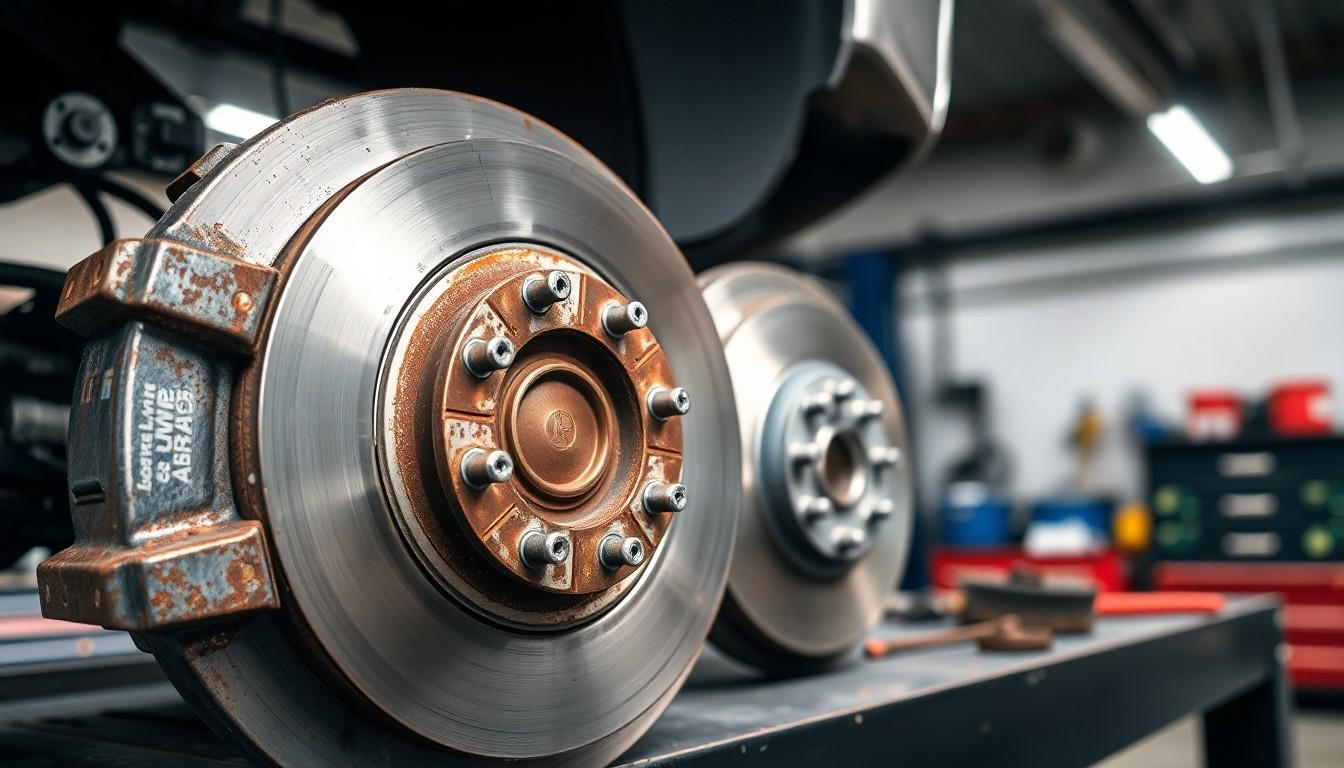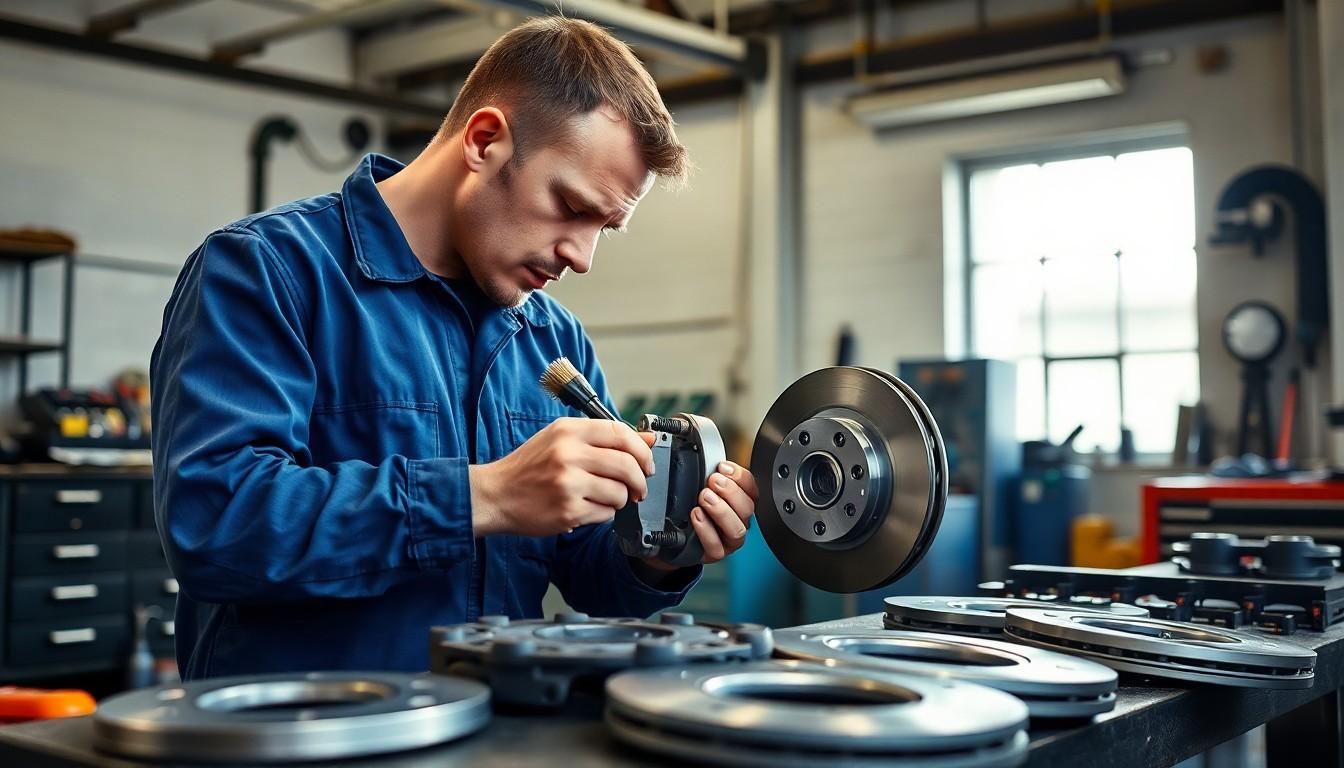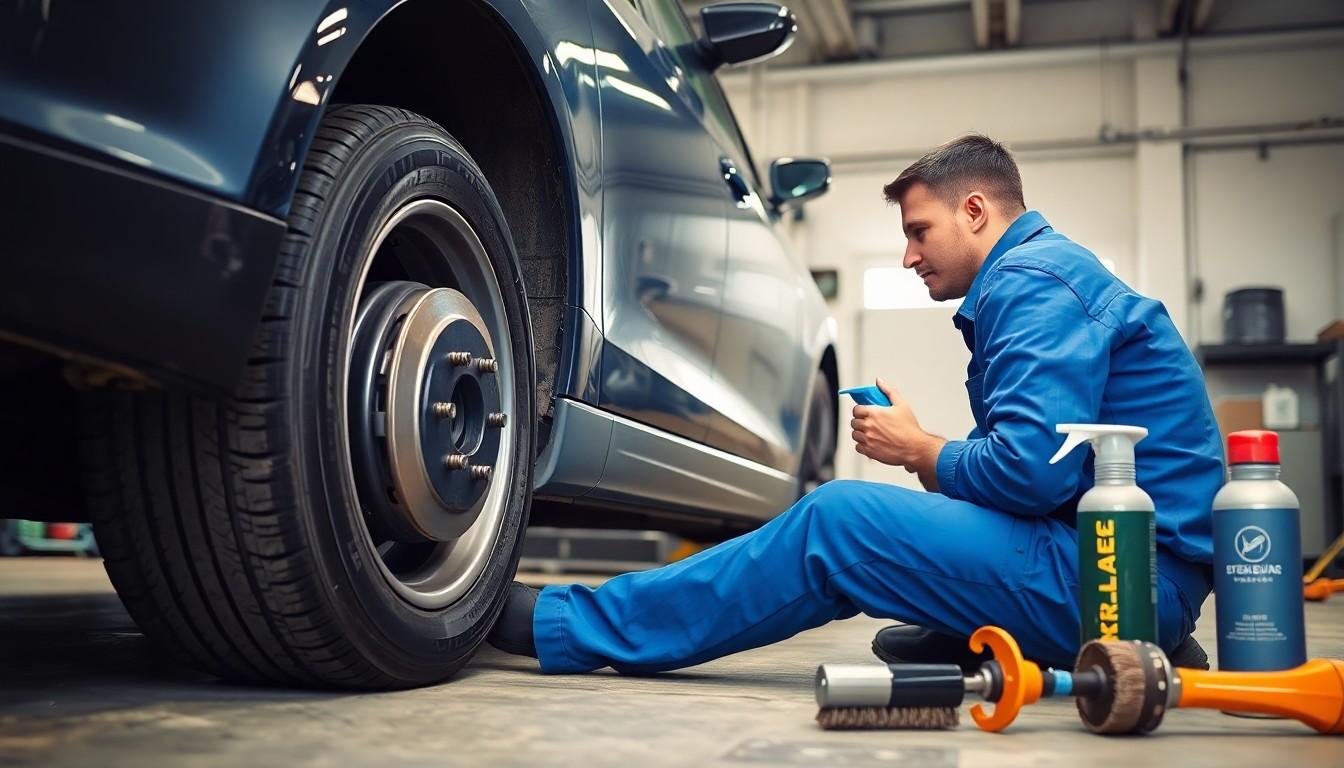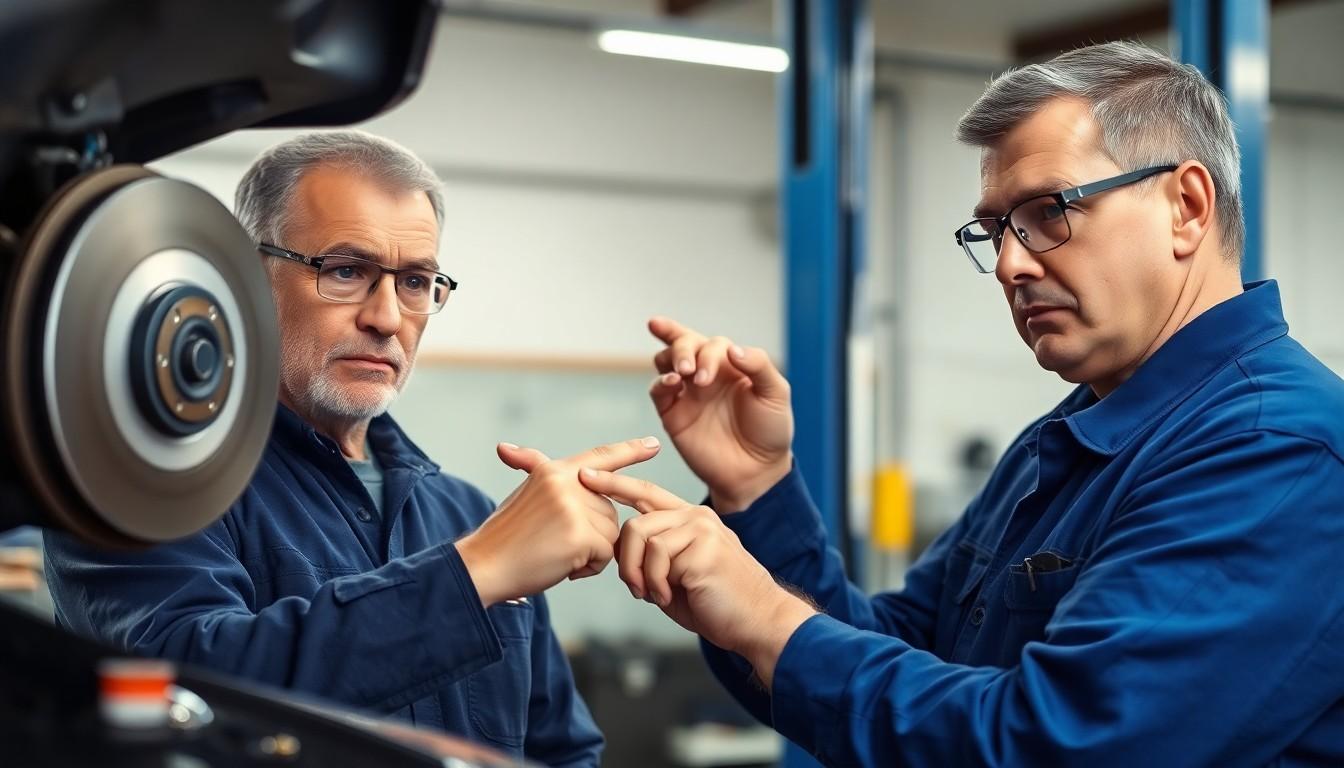Hearing that telltale scraping noise when you’re braking at low speed can instantly turn your peaceful drive into a stress-filled experience. It’s not just annoying—it could be your vehicle’s way of signaling that something needs attention before a minor issue becomes a major repair.
We’ve helped thousands of drivers diagnose and fix this common problem, and we’ll guide you through the most likely causes and answers. From worn brake pads to rusty rotors, understanding what’s behind that unsettling sound can save you time, money, and unnecessary worry. In this comprehensive guide, we’ll share our expert insights on identifying the source of brake scraping and determining whether it’s a DIY fix or time to visit a professional.
Understanding the Scraping Noise When Braking at Low Speed
Scraping noises during low-speed braking typically indicate exact issues with your vehicle’s braking components. These sounds aren’t just annoying—they’re warning signals from your braking system that something requires attention. Several components can create these distinctive scraping, grinding, or squealing sounds when you apply the brakes at lower speeds.
Brake pads with worn indicators are the most common source of scraping noises. Manufacturers design brake pads with small metal tabs that contact the rotor when the pad material wears down to about 25% of its original thickness. This deliberate design creates a scraping sound to alert drivers that brake pad replacement is necessary before complete wear occurs.
Rusty rotors frequently cause scraping sounds, especially after your vehicle has been parked overnight in humid conditions or following rain. A thin layer of rust forms on the rotor surface, creating a scraping noise when the brake pads make contact. This rust typically clears after a few braking applications as the pads scrape the oxidation from the rotor surface.
Foreign debris caught between brake components creates distinctive scraping sounds during braking. Small rocks, road salt, or other particles can become lodged between the rotor and backing plate or between the caliper and rotor. These unwanted objects interfere with normal braking operations, producing scraping noises primarily noticeable at low speeds.
Damaged brake hardware components contribute to scraping noises when they contact other parts during braking. Bent backing plates, loose caliper bolts, or damaged shims can all create metal-on-metal contact points that produce scraping sounds. These issues require prompt attention as they can accelerate wear on other braking components.
Glazed or unevenly worn brake pads sometimes create scraping noises at low speeds. When brake pads overheat and develop a hardened, glossy surface, they don’t grip the rotor properly. This condition not only reduces braking efficiency but also creates unusual noises during light braking applications common at low speeds.
Common Causes of Brake Scraping Noises

Scraping noises when braking at low speeds typically stem from several exact issues in your vehicle’s brake system. These sounds aren’t just annoying—they’re warning signs that shouldn’t be ignored.
Worn Brake Pads
Brake pads naturally wear down over time, becoming progressively thinner until they create a distinct scraping sound against the rotors. This noise intensifies as the pads continue to deteriorate, serving as an audible warning system for your vehicle. Many cars feature built-in wear indicators called “squeaker tabs” that deliberately contact the brake rotor once the pad material has worn to a critical threshold. These metal tabs create that characteristic scraping noise specifically to alert you that it’s time for brake pad replacement before further damage occurs to other components.
Debris Between Rotor and Caliper
Foreign objects lodged in your braking system commonly cause scraping noises during low-speed braking. Small rocks, road debris, or even broken fragments from the brake components themselves can become trapped between the rotor and caliper. This unwanted material creates friction against moving parts, producing distinctive scraping sounds that vary in intensity depending on the size and location of the debris. Removing these foreign objects promptly helps prevent potential damage to your brake system’s more expensive components.
Rusted Rotors
Brake rotors develop surface rust over time, especially after exposure to moisture or when vehicles sit unused for extended periods. This rust pits the rotor surface, creating uneven spots that produce scraping noises when the brake pads make contact. Damaged rotors from uneven wear due to faulty calipers or worn brake pads also generate similar sounds. Overheating caused by excessive braking can warp the rotors, further contributing to these unsettling noises and potentially compromising braking performance at low speeds.
How to Diagnose Brake Scraping Issues

Diagnosing brake scraping noises requires a systematic approach combining visual inspections and listening tests. We’ve compiled effective methods to help you identify the exact cause of that annoying scrape when you apply your brakes at low speeds.
Visual Inspection Techniques
Conducting a thorough visual inspection reveals many common brake issues without specialized tools. Look between the wheel spokes to examine if brake pads are pressing against the rotor. Brake pads thinner than ¼ inch typically need replacement, as new pads generally measure 8-10mm thick. Removing the wheel provides better access for a comprehensive inspection of both the pads and rotors.
Examine your rotors for smoothness and evenness. Run your finger along the cool rotor surface to detect grooves, ridges, or rough spots that may cause scraping. Blue discoloration indicates dangerous overheating, while deep scratches compromise braking performance. Uneven rust formation on the rotor edge commonly produces scraping noises, particularly during cornering maneuvers.
Clean and inspect the calipers and associated hardware using a wire brush for those hard-to-reach areas. Ensure all components fit properly with no visible gaps. Loose or damaged caliper hardware often creates intermittent scraping noises that worsen over time.
Listening Test Methods
Timing of the noise provides valuable diagnostic clues. Scraping that occurs immediately upon brake application often indicates rust buildup or debris contamination. Noise that intensifies with firmer pedal pressure suggests worn brake pads or damaged rotors requiring prompt attention.
Pay attention to noise intensity during your test drive. Light scraping sounds when first applying brakes frequently stem from minor issues like surface rust or small debris. Loud, harsh grinding noises signal serious problems—usually severely worn brake pads contacting rotors directly, causing expensive damage with each application.
Note when the noise changes based on vehicle speed and maneuvers. Scraping that increases during low-speed driving or cornering helps pinpoint whether the issue affects exact brake components. Sounds that appear only during tight turns might indicate problems with the brake pad retainer clips scraping against the rotor rather than the pads themselves.
When to Worry About Brake Scraping Sounds

Scraping noises when braking at low speeds can indicate several issues within your braking system. Understanding which sounds require immediate attention versus which are normal operation noises helps prevent costly repairs and ensures your safety on the road.
Normal Break-In Noises vs. Problem Indicators
Normal brake noises often occur during the first drive of the day or after rain when surface rust has formed on the rotors. This light scraping sound typically disappears after a few brake applications as the rust wears off. New brake pads might also produce temporary noises during their break-in period, which usually resolve after 100-200 miles of driving.
Problem indicators sound distinctly different and persist beyond normal conditions. Continuous grinding or metal-on-metal scraping signals worn brake pads that have exceeded their usable life. The built-in wear indicators (squeaker tabs) on many vehicles create a deliberate squeaking noise when pads need replacement. Rhythmic scraping that corresponds to wheel rotation suggests a warped rotor or damaged backing plate rubbing against components. Intermittent but recurring scraping noises point to loose wheel bearings or hub assemblies creating misalignment within the brake assembly.
Safety Concerns to Consider
Reduced braking performance represents the most immediate safety risk when you hear persistent scraping noises. Worn brake pads or damaged rotors significantly increase stopping distances, especially during emergency situations. A vehicle with compromised brakes might require up to 50% more distance to stop completely, creating dangerous conditions for everyone on the road.
Ignoring brake scraping sounds leads to cascading damage throughout the system. When brake pads wear completely, the metal backing makes direct contact with rotors, causing extensive damage to these expensive components. This metal-on-metal contact generates excessive heat that can warp rotors, damage calipers, and even compromise brake fluid integrity. Prompt attention to scraping noises typically results in simpler, less expensive repairs limited to pad replacement, while delayed action often necessitates complete brake system overhauls.
Addressing brake issues immediately not only preserves your safety but also protects your vehicle’s value. Regular brake inspections should be performed every 10,000-15,000 miles, with particular attention paid to any unusual noises that develop between scheduled maintenance intervals. Most brake pad replacement needs become evident through scraping or squealing long before catastrophic failure occurs, giving attentive drivers ample opportunity to address issues before they escalate.
DIY Solutions for Scraping Brake Noises

Several effective do-it-yourself remedies can address those annoying scraping noises coming from your brakes at low speeds. These answers focus on cleaning components and applying specialized products to reduce friction and eliminate unwanted sounds.
Cleaning Brake Components
Dirt and debris often cause scraping noises when lodged between brake parts. Begin by inspecting all brake components for foreign particles, rust accumulation, or other contaminants that might create friction. A thorough cleaning with brake cleaner spray removes most debris and dissolves brake dust that has built up over time.
Rusty backing plates frequently rub against rotors, creating persistent scraping sounds. Take a wire brush or medium-grit sandpaper to remove rust from backing plates, focusing on edges that might contact the rotor during braking. After cleaning, check that the backing plate maintains proper clearance from rotating components.
For optimal results, clean both the brake pads and rotors to ensure smooth contact surfaces. This simple maintenance step often resolves minor scraping issues without requiring part replacement.
Applying Anti-Squeal Products
Brake lubricants significantly reduce noise by minimizing friction between moving parts. Apply a specialized brake parts lubricant such as Permatex to the back of brake pads and contact points between the caliper and pad. This creates a protective barrier that prevents metal-on-metal contact while maintaining proper brake function.
Anti-squeal sprays offer a quick solution for minor scraping sounds. These products form a thin coating on brake components that dampens vibrations and reduces friction-related noise. Apply the spray to clean, dry brake parts according to manufacturer instructions for maximum effectiveness.
Specialized brake greases work particularly well for persistent scraping noises. Apply a small amount to the backs of brake pads and caliper contact points, being extremely careful to avoid getting any lubricant on the pad surface or rotor face. Even minimal contamination of friction surfaces can compromise braking performance.
For severe cases, consider installing shims between brake pads and calipers. These thin metal or composite pieces absorb vibrations and prevent direct contact between components, effectively eliminating many types of brake noise including scraping and squealing.
When to Seek Professional Brake Repair

Professional brake repair becomes essential when you notice consistent scraping noises during braking at low speeds. These sounds aren’t just annoying—they’re warning signals that require immediate attention to prevent further damage and ensure your safety on the road.
Safety Concerns
Driving with scraping or grinding brakes significantly compromises your vehicle’s stopping ability. The metal-on-metal contact causing these noises indicates serious brake system deterioration, increasing your stopping distance dramatically. Research shows that compromised brakes can add 20-30 feet to your stopping distance, creating dangerous situations in emergency braking scenarios. Every mile driven with grinding brakes compounds the damage, potentially leading to complete brake failure in extreme cases.
Immediate Attention
Brake scraping noises demand prompt professional assessment rather than continued driving. The grinding typically indicates that brake pads have worn completely, allowing metal components to contact your rotors directly. This metal-on-metal contact causes rapid deterioration of expensive brake components. Mechanics report that driving just 100 miles with grinding brakes can turn a simple pad replacement into a complete brake system overhaul, costing 3-4 times more than addressing the issue promptly.
Professional Diagnosis
Qualified mechanics possess specialized diagnostic equipment that pinpoints the exact cause of brake noise issues. Their trained ears can distinguish between different types of scraping sounds, identifying whether the problem stems from worn pads, damaged rotors, or faulty wheel bearings. Professional brake services include comprehensive system checks that examine calipers, brake lines, and hydraulic components—areas often overlooked in DIY inspections. Many repair shops also offer digital brake performance testing that measures stopping efficiency, providing concrete data about your braking system’s condition.
Cost Expectations for Brake Repairs
Brake repair costs vary based on your vehicle type and the exact components needing replacement. Brake pad replacement typically ranges from $50-$100 per axle for parts alone, with labor adding $80-$120, bringing the total to $130-$220 per axle. Rotor replacement costs substantially more, with parts ranging from $70-$200 each and labor adding another $140-$180 for a complete job. Premium vehicles often require specialty parts that can increase these costs by 40-60%.
Complete brake system overhauls become necessary when problems persist untreated, potentially costing $500-$1,000+ depending on vehicle make and model. Many repair shops offer free brake inspections, making it economical to have suspicious noises checked before they escalate into major repairs. Addressing brake issues promptly typically saves an average of $300-$500 compared to waiting until complete failure occurs.
Preventing Future Brake Scraping Noises

Regular Brake System Maintenance
Regular maintenance prevents most brake scraping issues before they start. Brake pads typically need replacement every 25,000 to 70,000 miles, depending on your driving habits and the pad material. Scheduling professional brake inspections at least once a year helps catch potential problems early. Visual checks of your brake components can be performed whenever you rotate your tires (approximately every 5,000-8,000 miles). Cleaning brake assemblies periodically removes built-up debris and prevents unnecessary friction between components.
Timely Replacement of Brake Parts
Replacing worn brake pads promptly eliminates the most common cause of scraping noises. Pay attention to any wear indicators on your brake pads—these small metal tabs create noise specifically to alert you when replacement is necessary. Fresh rotors or resurfacing existing ones removes grooves and imperfections that contribute to scraping sounds. Replacing damaged backing plates prevents metal-on-metal contact that creates distinctive scraping noises at low speeds.
Proper Component Lubrication
Applying brake-exact lubricant to contact points reduces friction-related noises. Lubricate the backs of brake pads and areas where they contact the caliper brackets to minimize movement and vibration. High-temperature brake grease works best on sliding components like caliper pins and brackets. Anti-seize compounds protect metal-to-metal contact points from corrosion without compromising braking performance.
Quality Replacement Parts
Installing high-quality brake components reduces the likelihood of noise issues. Premium brake pads often include built-in shims and noise-reduction technology. OEM (Original Equipment Manufacturer) parts typically provide better fit and performance than bargain alternatives. Ceramic brake pads generate less noise and dust compared to semi-metallic options. Complete brake kits that include matched pads, rotors, and hardware ensure all components work together harmoniously.
Addressing Environmental Factors
Parking in covered or dry areas minimizes rust formation on brake rotors. Taking short drives occasionally prevents moisture buildup when a vehicle sits unused for extended periods. Applying several light brake applications after driving through water helps dry the brake components. Seasonal inspections before winter and summer account for how extreme temperatures affect brake system performance and noise characteristics.
Professional Inspections
Professional mechanics can spot early signs of brake wear using specialized equipment. Complete brake system inspections include checking wheel bearings and hub assemblies that contribute to misalignment issues. Technicians evaluate brake fluid condition, as contaminated fluid can accelerate component wear. Many repair shops offer free brake inspections, making preventative maintenance both accessible and economical for maintaining quiet, effective brakes.
Conclusion
Addressing scraping noises when braking at low speeds isn’t just about eliminating an annoying sound—it’s about ensuring your safety on the road. We’ve seen how these noises typically stem from worn brake pads rust formation or debris caught between components.
Don’t ignore these warning signs. What starts as a minor scraping can quickly escalate into major brake system damage and costly repairs. Whether you choose DIY answers like cleaning components and applying anti-squeal products or seek professional help remember that regular maintenance is your best defense.
By following preventive measures including scheduled inspections using quality replacement parts and addressing issues promptly you’ll keep your braking system functioning smoothly. Your safety and wallet will thank you for taking these warning sounds seriously.
Frequently Asked Questions
What causes scraping noise when braking at low speeds?
Scraping noises during braking typically stem from worn brake pads with exposed indicators, rusty rotors, foreign debris caught between brake components, damaged hardware, or glazed brake pads. The most common cause is worn-down brake pads where the built-in “squeaker tabs” contact the rotor to alert you it’s time for replacement. Surface rust on rotors after parking in humid conditions can also create temporary scraping sounds.
How can I tell if my brake pads need replacement?
Inspect your brake pads visually through the wheel spokes. If they appear less than ¼ inch thick, they need replacement. Listen for persistent scraping or grinding noises when braking, which indicate worn pads. Pay attention to performance changes like reduced braking efficiency or your vehicle pulling to one side when stopping. Regular inspections every 10,000-15,000 miles help catch issues before they become serious problems.
Is it safe to drive with scraping brakes?
No, it’s not safe to drive with consistently scraping brakes. While temporary scraping from surface rust is normal, persistent grinding or metal-on-metal sounds indicate serious issues that compromise braking performance. These conditions significantly increase stopping distances and can lead to complete brake failure. Continuing to drive with grinding brakes will cause cascading damage throughout your braking system, dramatically increasing repair costs.
Can I fix scraping brakes myself?
Some brake scraping issues can be addressed with DIY solutions. You can clean brake components with brake cleaner spray to remove dirt and debris, apply anti-squeal products to reduce friction, or install shims between brake pads and calipers to absorb vibrations. However, if the noise persists or you notice significant wear on brake components, professional inspection is necessary for safety reasons.
How much does it cost to fix scraping brakes?
Brake repair costs vary depending on the issue. Simple brake pad replacements typically range from $130 to $220 per axle. If rotors need replacement, costs increase significantly, potentially reaching $300 to $500 per axle. Complete brake system overhauls can exceed $1,000. Many repair shops offer free brake inspections, which can help identify issues early before they require major repairs, ultimately saving money.
How often should brake pads be replaced?
Brake pads typically need replacement every 25,000 to 70,000 miles, depending on your driving habits and conditions. Highway drivers may get longer life from their pads than city drivers who frequently stop and start. Visual inspections during tire rotations (every 5,000-7,000 miles) can help catch potential problems early. Professional inspections at least once yearly ensure optimal brake system performance and safety.
Why do my brakes only scrape in the morning or after rain?
Morning or post-rain scraping is usually caused by surface rust that forms on the rotors when the vehicle sits in humid conditions. This thin layer of rust creates a scraping sound during the first few brake applications as the pads clean the rotors. This phenomenon is normal and typically resolves after a few stops. If the sound persists beyond initial braking, it may indicate a more serious issue.
What’s the difference between squealing and scraping brake noises?
Squealing typically indicates high-frequency vibrations between brake components, often caused by glazed pads or lack of lubrication on contact points. Scraping sounds are lower-pitched, grinding noises that suggest direct metal-on-metal contact from worn pads, damaged rotors, or debris caught in the system. While squealing is often an early warning, scraping usually indicates more advanced wear requiring immediate attention.

